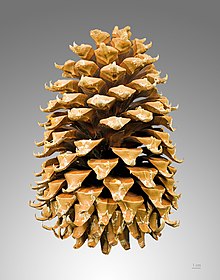**1. Conifer Families and Cone Characteristics:**
– Pinaceae cones have bract and seed scales.
– Pine cones have two ovules per seed scale.
– Maturation of Pinaceae cones takes 6-24 months.
– Pine cones open and close based on moisture for seed dispersal.
– Araucariaceae cones have fused bract and seed scales.
– Podocarpaceae cones are berry-like with fused scales attracting birds for seed dispersal.
– Cupressaceae cones have fully fused bract and seed scales.
– Taxaceae and Cephalotaxaceae cones have highly modified cones with poisonous ovules and sweet arils.
– Welwitschiaceae cones are unique and found in the Namibian desert.
**2. Cone Distribution and Reproduction:**
– Location and distribution of conifers vary, with male and female cones on the same plant in Australia.
– Diversity in cone bearing in different conifer families.
– Cone crops can be predicted by weather conditions.
– Experienced observers can detect differences in reproductive buds.
**3. Cultural and Practical Uses of Conifer Cones:**
– Conifer cones used in arts and crafts worldwide, including wreaths, decorations, and bird feeders.
– Traditional toys like cone cows are popular in Finland and Sweden.
– Cones used in architecture and heraldic coats of arms.
– Pine cones used in family-friendly craft projects and traditional outfits.
– Unique pine cone preserves available for consumption.
**4. Pine Cone Studies and Research:**
– Study in Nature journal shows pine cones open.
– White and black spruce cone crops predictable.
– Viability of white spruce seed from squirrel-cut cones studied.
– Technique for cone collection developed.
– Historical research on cone crops of spruce trees.
**5. Additional Resources and External Links:**
– Wikimedia Commons resources on conifer cones.
– Gymnosperm cone images available online.
– Additional resources for conifer cone enthusiasts.
– Visual references for studying conifer cones.
– Research studies on specific conifer species like Picea glauca.
This article needs additional citations for verification. (June 2009) |
A conifer cone or pinecone (strobilus, pl.: strobili in formal botanical usage) is a seed-bearing organ on gymnosperm plants. It is usually woody, ovoid to globular, including scales and bracts arranged around a central axis, especially in conifers and cycads. The cone of Pinophyta (conifer clade) contains the reproductive structures. The woody cone is the female cone, which produces plants. The male cone, which produces pollen, is usually herbaceous and much less conspicuous even at full maturity. The name "cone" derives from Greek konos (pine cone), which also gave name to the geometric cone. The individual plates of a cone are known as scales. The umbo of a conifer cone refers to the first year's growth of a seed scale on the cone, showing up as a protuberance at the end of the two-year-old scale.[citation needed]



The male cone (microstrobili or pollen cone) is structurally similar across all conifers, differing only in small ways (mostly in scale arrangement) from species to species. Extending out from a central axis are microsporophylls (modified leaves). Under each microsporophyll is one or several microsporangia (pollen sacs).
The female cone (megastrobilus, seed cone, or ovulate cone) contains ovules which, when fertilized by pollen, become seeds. The female cone structure varies more markedly between the different conifer families, and is often crucial for the identification of many species of conifers.
